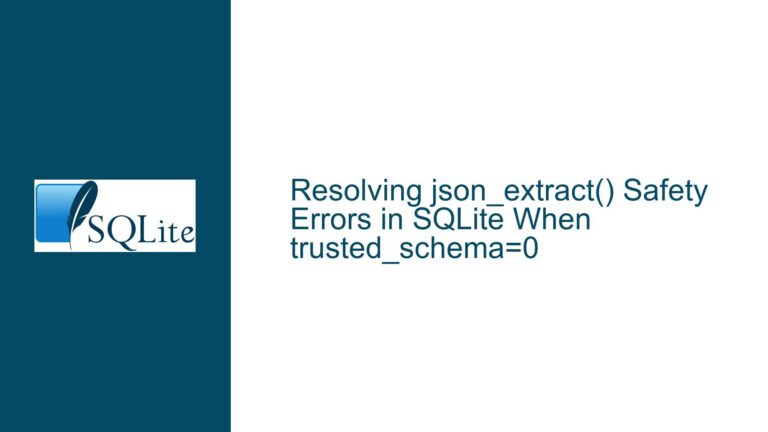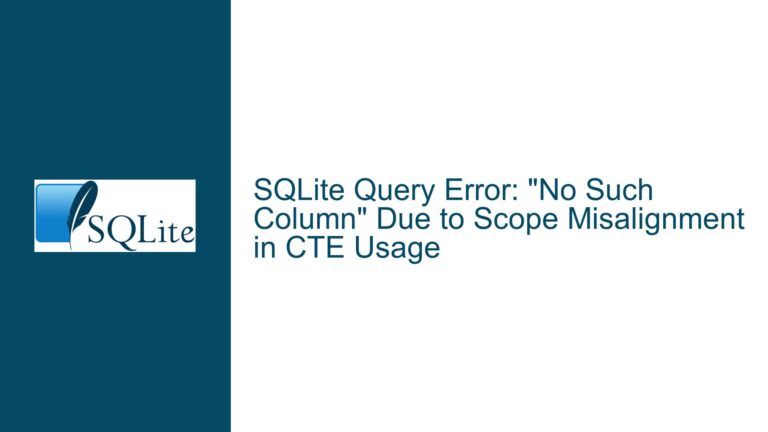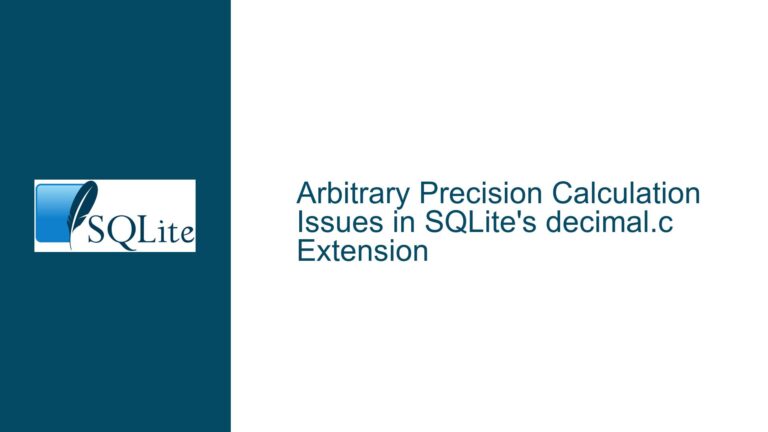Handling SQLite Aggregate Functions in Tcl When Tables Are Empty
Understanding the Behavior of Aggregate Functions in SQLite with Empty Tables
When working with SQLite in Tcl, one of the common challenges developers face is understanding how aggregate functions behave when applied to empty tables. Specifically, the behavior of the MAX() function, or any other aggregate function, can be counterintuitive when the table has no rows. This issue becomes particularly important when you need to handle the result of such queries in Tcl, where the distinction between an empty string, a list, and NULL values can lead to subtle bugs if not handled correctly.
In SQLite, aggregate functions like MAX(), MIN(), SUM(), and COUNT() are designed to return NULL when applied to an empty set of rows. This is consistent with the SQL standard, which defines that aggregate functions over an empty set should return NULL. However, when this result is passed to Tcl, the NULL value is represented as an empty list {}. This behavior can be confusing, especially when you expect the result to be an empty string or a different representation of NULL.
The confusion arises because Tcl does not have a native concept of NULL. In Tcl, everything is a string, and NULL values from SQLite are typically converted to empty strings or empty lists. This conversion can lead to unexpected behavior in your Tcl scripts, especially when you are trying to check for the presence of a valid result from an SQL query. For example, if you run a query like SELECT MAX(timestamp) FROM ur_maps on an empty table, SQLite will return NULL, but Tcl will interpret this as an empty list {}. This can cause issues if your Tcl code is not designed to handle this case explicitly.
Why SQLite Returns NULL for Aggregate Functions on Empty Tables
The behavior of SQLite’s aggregate functions on empty tables is rooted in the SQL standard. According to the standard, when an aggregate function is applied to an empty set of rows, the result should be NULL. This is because aggregate functions are designed to operate on a set of values, and when there are no values to aggregate, the result is undefined. In SQLite, this undefined state is represented as NULL.
For example, consider the following query:
SELECT MAX(timestamp) FROM ur_maps;
If the ur_maps table is empty, SQLite will return NULL for the MAX(timestamp) expression. This is because there are no rows to evaluate, and thus no maximum value can be determined. The same logic applies to other aggregate functions like MIN(), SUM(), and AVG(). In the case of COUNT(), the result is 0 for an empty table, which is a special case since COUNT() is designed to return the number of rows, and zero is a valid count.
When this NULL value is passed to Tcl, it is converted to an empty list {}. This conversion is part of the SQLite Tcl interface, which maps SQL NULL values to Tcl’s empty list representation. This behavior is consistent with Tcl’s philosophy of treating everything as a string, but it can be confusing if you are not aware of the underlying mechanics.
Best Practices for Handling Aggregate Function Results in Tcl
To handle the results of aggregate functions in Tcl correctly, you need to account for the possibility of an empty table and the resulting NULL value. There are several approaches you can take to ensure that your Tcl code handles these cases gracefully.
One common approach is to use the IFNULL() function in your SQL query to replace NULL with a default value. For example, you can modify your query to return -1 or some other sentinel value when the table is empty:
SELECT IFNULL(MAX(timestamp), -1) FROM ur_maps;
In this case, if the ur_maps table is empty, the query will return -1 instead of NULL. This makes it easier to handle the result in Tcl, as you can simply check if the result is -1 to determine if the table was empty.
Another approach is to initialize a variable in Tcl with a default value before executing the query. For example:
set maxTimeStamp -1
$dbusr eval {SELECT MAX(timestamp) FROM ur_maps} {
set maxTimeStamp $timestamp
}
In this example, the maxTimeStamp variable is initialized to -1 before the query is executed. If the table is empty, the query will not modify the variable, and it will retain its initial value. This allows you to check if maxTimeStamp is still -1 after the query to determine if the table was empty.
A third approach is to use the COALESCE() function in your SQL query, which works similarly to IFNULL() but can handle multiple arguments. For example:
SELECT COALESCE(MAX(timestamp), -1) FROM ur_maps;
This query will return the maximum timestamp if the table is not empty, or -1 if the table is empty. This approach is useful if you want to handle multiple possible NULL values in a single query.
Debugging and Testing Your Tcl Code with SQLite
When working with SQLite in Tcl, it is important to thoroughly test your code to ensure that it handles all possible edge cases, including empty tables. One way to do this is to create a test table with no rows and run your queries against it to see how your Tcl code behaves. For example:
CREATE TABLE ur_maps (id TEXT, timestamp INTEGER);
After creating the table, you can run your queries and check the results in Tcl:
set maxTimeStamp [$dbusr eval {SELECT MAX(timestamp) FROM ur_maps}]
if {$maxTimeStamp eq {}} {
puts "The table is empty."
} else {
puts "The maximum timestamp is $maxTimeStamp."
}
This code will print "The table is empty." if the ur_maps table is empty, or "The maximum timestamp is …" if the table contains rows.
Another useful technique is to use the explain command in SQLite to see how your queries are being executed. This can help you understand why a query is returning a particular result, especially if the result is unexpected. For example:
EXPLAIN SELECT MAX(timestamp) FROM ur_maps;
This command will show you the execution plan for the query, which can help you identify any issues with the query or the table structure.
Conclusion: Ensuring Robust Handling of Aggregate Functions in Tcl
Handling the results of aggregate functions in SQLite when working with Tcl requires a clear understanding of how SQLite represents NULL values and how Tcl interprets them. By using functions like IFNULL() or COALESCE() in your SQL queries, and by initializing variables with default values in Tcl, you can ensure that your code handles empty tables and NULL values correctly. Additionally, thorough testing and debugging are essential to catch any edge cases and ensure that your code behaves as expected in all scenarios.
By following these best practices, you can avoid common pitfalls and ensure that your Tcl scripts work reliably with SQLite, even when dealing with empty tables and aggregate functions. This will help you build more robust and maintainable applications that can handle a wide range of data scenarios.






